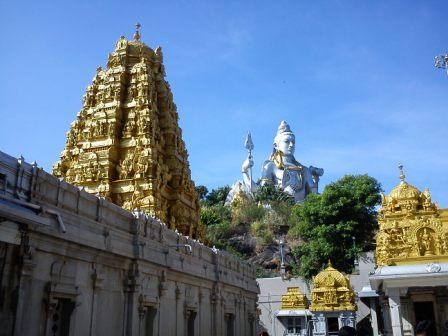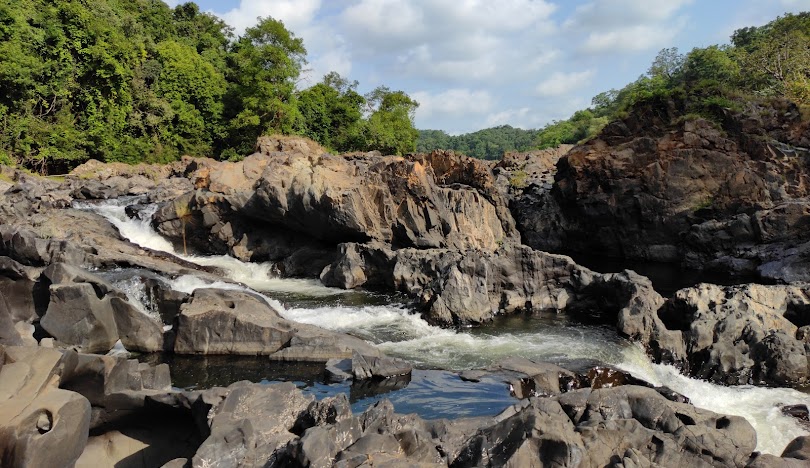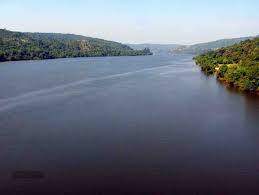- The legend of the Atmalinga is central to the significance of the Mahabaleshwar Temple in Gokarna. According to the myth, Ravana, the demon king of Lanka from the Ramayana, once carried the Atmalinga from Mount Kailash with the intention of taking it to Lanka. However, due to a series of divine events, the Atmalinga was placed at Gokarna, where it remains deified today. This makes Gokarna one of the holiest sites for Lord Shiva, frequently mentioned in several ancient texts, including the Puranas, Ramayana, and Mahabharata.
- The origins of the Mahabaleshwar Temple date back to the 4th century CE, when King Mayurasharma of the Kadamba dynasty (reigned 345–365 CE) is believed to have first constructed it. Legend tells that King Mayurasharma, desiring to learn Vedic rites and the Ashwamedha Yagna (the horse sacrifice ritual), traveled to Kanchipuram, a major center of religious learning. There, he was insulted by a guard. Enraged, he vowed to defeat the ruling Pallava dynasty. After his victory, the king requested priests to perform daily yajnas (rituals) to maintain his sovereignty over the region. His son, King Kangavarma, later brought Brahmin families from various lineages to administer the temple.
- The famous classical Sanskrit writer Kalidasa referred to the temple as the "Lord of Gokarna" in his 4th-century work, Raghuvamsha. Over time, the temple complex expanded, particularly during the Vijayanagara Empire period (1336–1646 CE). A Vijayanagara emperor is said to have visited the temple and weighed himself in gold as a gesture of devotion.
- The 17th century saw further developments under the reign of Queen Chennammaji and her son, Soma Sekharanayaka of Keladi. Visvesvaraya of Halasunadu-Kundapura built the Chandrasala and Nandi pavilions. In 1665, the renowned warrior king Shivaji visited the Mahabaleshwar Temple after disbanding his army in Gokarna.
- During the Maha Shivaratri festival of 1676, the English traveler Fryer visited Gokarna and documented his observations of the temple in great detail. His account remains a valuable historical record of the temple during that period.
PURANIC SIGNIFICANCE 1:
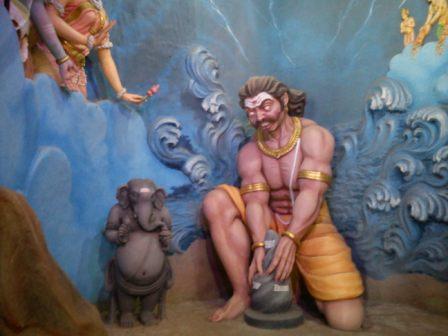

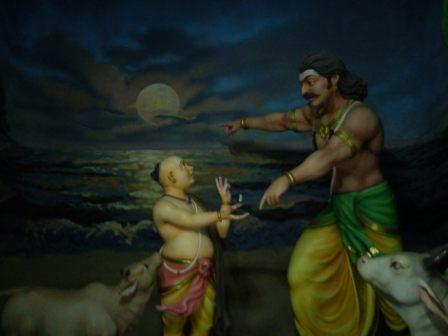
The Story of Mahabaleshwar Temple and Ravana's Encounter with Lord Shiva
1. Ravana's Worship at Mount Kailash
The story of Mahabaleshwar Temple is deeply intertwined with the mighty demon king, Ravana. Ravana, known for his strength and devotion to Lord Shiva, meditated intensely at Mount Kailash, the abode of Lord Shiva. His worship was so intense that Lord Shiva was pleased with his devotion and appeared before him.
2. Lord Shiva Grants the Aatmalinga
Impressed with Ravana's unwavering devotion, Lord Shiva granted him a divine boon. He gave Ravana an Aatmalinga, a powerful Shiva Linga that was said to grant immortality to its possessor. Lord Shiva told Ravana that he could place the Linga wherever he wished, and it would bring him immense power.
3. The Condition: A Strict Warning
Lord Shiva, however, warned Ravana that the Linga should not be placed on the ground until he reached his destination. Ravana, eager to return to his capital, Lanka, decided to carry the Aatmalinga with him. He placed strict instructions on a Brahmin child (who is believed to have been Lord Ganesha in disguise), forbidding him from placing it on the ground.
4. The Trick of Lord Ganesha (Disguised as the Brahmin Kid)
As Ravana was on his journey back, the time for his evening prayers arrived. Ravana entrusted the Linga to the Brahmin child and instructed him to hold it carefully. But, as part of a divine plan, the Brahmin child, believed to be Lord Ganesha in disguise, mischievously tricked Ravana. He asked Ravana to place the Linga on the ground temporarily. The moment the Linga touched the ground, it became immovable.
5. Ravana's Fury and the Origin of the Name Gokarna
Furious at being deceived, Ravana chased after the child, determined to retrieve the Linga. During this chase, Ravana grabbed a cow by its ear, which is believed to be the origin of the name "Gokarna," where Go means cow and Karna means ear. This incident is a pivotal part of the story behind the place name Gokarna.
6. The Shiva Linga Fragments and the Temples Built
Ravana, in his rage, tried to forcibly remove the Linga, but only parts of it broke off. These pieces, now sacred, fell in different locations, where temples were eventually built. These include famous temples such as:
Surathkal
Dharwad
Gunavant Shivar
Murudeshwar
Shijeshvar
Each of these temples is believed to house parts of the divine Aatmalinga.
7. The Name Mahabaleshwar
Despite Ravana's defeat, the power of the Shiva Linga triumphed. In honor of the divine power, Ravana gave the place the name Mahabaleshwar, meaning "the place of great power," reflecting the immense spiritual and divine energy of Lord Shiva.
The Hoary Legend of Mahabaleshwar and Gokarna
The legend surrounding the Mahabaleshwar Temple and Gokarna’s Bhadra Kali Temple is closely linked to Ravana, the demon king of Lanka, and his devotion to Lord Shiva. This story also provides the etymology of the name "Gokarna."
Ravana's Mother's Devotion and the Stolen Shiva Linga
Ravana’s mother, a devout worshipper of Lord Shiva, was performing a ritual with a Shiva Linga to bring prosperity to her son. Jealous of her devotion, Indra, the king of the gods, stole the Shiva Linga and cast it into the sea. Distraught, Ravana’s mother fasted and went on a hunger strike, unable to continue her worship without the sacred Linga.
Ravana's Promise and Journey to Mount Kailash
In response to his mother’s distress, Ravana vowed to bring the original Atmalinga from Mount Kailash, the divine abode of Lord Shiva. To fulfill this promise, Ravana undertook severe penance and sang praises of Shiva, including the famous Shiva Tandava Stotram. His devotion was so intense that he even cut off his own head and used his skin and intestines to make a harp. Impressed by Ravana’s devotion, Lord Shiva appeared before him and granted him a boon.
The Divine Boon and the Condition
Ravana requested the Atmalinga as his boon. Lord Shiva agreed but placed a condition: wherever the Atmalinga was placed on the ground, it would remain rooted there permanently, and could not be moved by anyone. With this divine boon, Ravana set out on his journey back to Lanka with the Atmalinga.
Lord Vishnu's Trick and Ganesha's Disguise
As Ravana neared Gokarna, Lord Vishnu blotted out the sun, creating the appearance of dusk. Ravana, eager to perform his evening rituals, was troubled because he could not hold the Atmalinga and complete his prayers. At this moment, Lord Ganesha, disguised as a Brahmin boy, approached Ravana. Ravana entrusted Ganesha with the Atmalinga, on the condition that it should not be placed on the ground.
Ganesha, agreeing to the arrangement, struck a deal with Ravana. He would hold the Atmalinga for Ravana but would place it on the ground if Ravana did not return within three calls. Ganesha called out three times rapidly, and Ravana was unable to return in time. Before Ravana could get back, Ganesha placed the Atmalinga on the ground, tricking Ravana.
Ravana's Pursuit and the Origin of Gokarna's Name
In his fury, Ravana chased after the Atmalinga and Ganesha, who had vanished with his cows. As the cow disappeared underground, Ravana managed to grab the ear of the cow, but the rest of its body had gone beneath the earth. This ear of the cow, believed to have petrified, became the origin of the name "Gokarna." In Sanskrit, go means cow, and karna means ear, thus giving the place its name, "Gokarna," meaning "cow’s ear."
Ravana’s Failure and the Name Mahabaleshwar
Ravana, in his desperation, tried to lift the Atmalinga, but it remained immovable, firmly rooted in the ground. Exhausted and defeated, Ravana realized the immense power of the Atmalinga. Unable to remove it, he fainted. In acknowledgment of the Atmalinga’s great power, Ravana named it "Mahabaleshwar," which means "all-powerful."
The Three Divine Entities of Gokarna
According to this legend, Gokarna became a sacred place of worship, encompassing three divine entities:
Gokarna – The cow's ear, representing the spot where Ravana failed to remove the Atmalinga.
The Atmalinga – The Shiva Linga that was deified in the Mahabaleshwar Temple, representing the immense power of Lord Shiva.
Goddess Bhadrakali – The goddess whose temple is an integral part of Gokarna, adding to the spiritual significance of the place.
Thus, the legend of Ravana’s encounter with the Atmalinga links these divine places in Gokarna, making it a revered destination for devotees.
ADMINISTRATION:
The Mahabaleshwar Temple in Gokarna is administered by the Temple Trust. It is a Hindu temple dedicated to Lord Shiva, specifically housing the Atmalinga. The temple is a significant pilgrimage site in Karnataka, managed by local religious authorities with involvement from the state government for its maintenance and governance.
